
Wood pellets can help Nova Scotia public buildings achieve 75% of climate targets: study
April 26, 2022
By Gordon Murray
 Photo: Annex Business Media
Photo: Annex Business Media Local sawdust and forest residuals could play a key role in helping Nova Scotia convert more than 100 public buildings to wood pellets for heat instead of oil furnace systems according to a recent feasibility study by M&R Engineering in Halifax on behalf of Wood Pellet Association of Canada (WPAC) members.
Nova Scotia’s Environmental Goals and Climate Change Reduction Act has a goal to decrease greenhouse gas (GHG) emissions across government-owned buildings by 75 per cent by 2035. With heating and domestic hot water accounting for close to half of the energy use in commercial and institutional buildings in Atlantic Canada, eliminating furnace oil is essential to achieve this 2035 target.
The M&R study, funded by WPAC, Shaw Renewables and Nova Scotia Public Works, demonstrates that switching to a biomass fuel source will help to achieve the 75 per cent target easily as they are the cleanest fuel source with negligible emissions.
The study authors looked at five categories of buildings with oil furnace systems and categorized them based on annual fuel consumption. The buildings selected were:
- The Digby Lockup (<7,000L)
- Noel 5-Bay Garage (7,000-30,000L)
- Port Hawkesbury Provincial Building (30,000-50,000L)
- Kentville Justice Centre (50,000-100,000L)
- Port Hawkesbury Justice Centre (100,000+L)
For each building, the study compared the initial cost, energy cost (including carbon cost) and carbon emissions over a period of 25 years for the alternative systems wood pellets, wood chips (only analyzed in larger fuel use building categories), electric boiler, air-to-water heat pump with electric boiler and status quo option: furnace oil.
The life cycle economics analysis confirmed that:
- For the buildings with an annual oil consumption of less than 30,000L, wood pellets are the most economical alternative system.
- For the building with an annual oil consumption of more than 100,000L, wood chips are the most economical alternative system.
- For the buildings with an annual oil consumption of between 30,000L to 100,000L, the results vary based upon the closeness of the site to local pellet producers, which will lead to lower wood pellet delivery cost, and the ability of the building to hold a pellet boiler in the existing boiler room, which will lead to lower initial cost.
- For the location that shows both pellet and chips as the economical alternative system between 30,000L to 100,000L oil consumption category, they will be subjected to availability of the wood chips close to the site and the quality of the chips delivered.
Of course, in addition to their lower cost, Canadian wood pellets have other advantages:
- negligible inventory GHG emissions and already meets the 75 per cent GHG emissions reduction in all government buildings target in year 2022;
- locally sourced, hence helps in supporting the local economy;
- fuel cost is unaffected by carbon cost under cap and trade and federal carbon tax program;
- will not be impacted by the forthcoming federal Clean Electricity Standard, which may further increase electricity cost projections used in this study; and
- fuel cost stability and local pellet producers’ capacity to serve all the Department of Public Work’s sites.
This is a ground-breaking study in Canada and sets the stage for policy makers, architects, public institutions, governments and others to start factoring in Canadian wood pellets into their decision making. There’s no debate: wood pellets will save taxpayers money, support local economies, enhance forest health and help achieve local climate targets.
WPAC will be communicating to those very decision makers and influencers over the coming months, and encourages everyone to help spread the word. Read the study here.
Gordon Murray is the executive director of the Wood Pellet Association of Canada.
Print this page